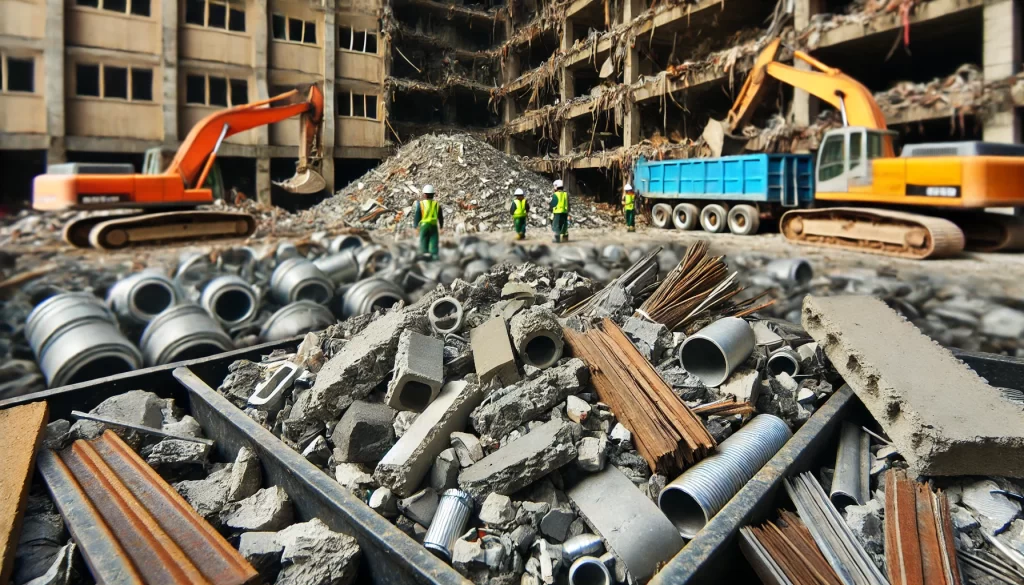In the world of construction, we’re used to seeing the new rise from the old. But what happens to the old? It’s a question that’s gaining importance as we face the environmental impact of our actions. We’re turning our attention to the potential goldmine that’s often overlooked: Demolition sites.
Demolition sites are more than just piles of rubble. They’re treasure troves of reusable materials, waiting to be discovered and given a new lease on life. From bricks and beams to doors and windows, the opportunities for recycling and reusing are abundant.
Read on to delve into the fascinating world of recycling and reusing materials from demolition sites. We’ll explore the process, the benefits, and the impact it can have on our planet. It’s not just about reducing waste—it’s about building a sustainable future.

The Importance of Recycling and Reusing Materials From Demolition Sites
Beyond the dusty chaos of demolition sites lies a remarkable opportunity for both environment conservation and economic growth. Tapping the potential of this untapped sector can yield significant benefits:
Environmental Benefits
There exist manifold environmental advantages to recycling and reusing materials from demolition sites. Primarily, it significantly diminishes the stress on our natural resources. Mining for raw materials such as clay for bricks or sand for concrete, for instance, can wreak havoc on the ecosystem. Using materials from demolition sites instead greatly reduces this adverse impact.
Another key environmental benefit is the reduction in waste destined for landfills. Disposal of construction materials in landfills has two main disadvantages. Firstly, it takes up precious space that could be utilized more productively. Secondly, it may lead to leaching of harmful chemicals, posing a threat to groundwater sources. By recycling and reusing, we take a preventive step toward safeguarding our environment.
Economic Impact
The economic impact of recycling and reusing materials from demolition sites is as substantial as its environmental advantages. Reclaimed materials often cost less compared to new materials. Therefore, construction firms can drastically cut down on expenses associated with acquiring new construction materials.
Moreover, recycling construction waste opens up new avenues for revenue generation. Instead of paying for waste disposal, companies can sell reusable items, turn a profit, and stimulate the local economy. For instance, salvaged wood can be sold to furniture industries, steel can be resold to the steel industry, and bricks can be sold to homeowners for DIY projects.
The environmental and economic benefits establish the importance of recycling and reusing materials from demolition sites. In the long run, this practice promotes sustainability and fiscal prudence in the construction industry.
Common Materials Recycled from Demolition Sites
Unlocking the potential of recycling starts with identifying and harnessing valuable materials commonly found on demolition sites.

Concrete and Asphalt
Arguably, the most abundant materials in demolition sites are concrete and asphalt. Contractors extract these materials, crush them into a reusable state, and repurpose them into new construction projects. For instance, crushed concrete serves as excellent backfill material, a base for new roads, as well as creating new concrete. On the other hand, ground asphalt finds a second life in road paving or as a sturdy base for driveways and paths.
Metals
On demo sites, metals arise primarily as structural steel from building frameworks and copper from wiring. The beauty of metals lies in their infinite recyclability without losing their properties. After separation and processing, structural steel can be remanufactured into new steel products, while copper, free from insulation and contaminants, joins the production line for electrical applications, plumbing fixtures, and architectural elements.
Wood
Finally, wood, often found in beam and flooring forms, proves a hot commodity for recycling. Employing various techniques, such as de-nailing, cutting, and planing, old wood converts into reclaimed lumber. Boasting a unique aesthetic and superior longevity, reclaimed lumber finds use in interior designs, furniture creation, and unique architectural applications. As a bonus, recycling wood significantly reduces the demand for newly harvested timber, serving as an active step toward environmental sustainability.
Challenges in Recycling Demolition Materials
Transitioning to practices that prioritize recycling and reusing materials, despite their clear environmental and economic benefits, presents a set of unique challenges. These obstacles often arise due to issues related to sorting and contamination, as well as logistical and regulatory hurdles.
Sorting and Contamination
An immediate challenge in recycling demolition materials involves handling waste segregation and contamination. Demolition sites often contain a mixed assortment of materials, challenging the practicalities of sorting out what can be recycled. Contaminations, for instance, from lead-based paints or asbestos, can pose health risks and complicate recycling processes.
Logistical and Regulatory Hurdles
Transporting heavy materials from demolition sites to recycling facilities presents logistical challenges. Considering the fuel costs and carbon emissions associated with transportation, the notion of recycling could lose some of its appeal. On the regulatory side, while many localities have encouraged recycling and reusing materials, others have yet to establish a consistent regulatory framework. The lack of standard regulations can create difficulties for construction firms keen on being part of a sustainable future in the industry.
Innovative Techniques in Demolition Recycling
Innovative techniques are continuously emerging to overcome recycling challenges in the demolition industry. Such techniques mainly address sorting issues and devise ways to reuse materials in new construction projects.
Advanced Sorting Technology
Sorting remains a pivotal stage in the recycling process where waste materials are separated for further processing. Automating the sorting process is rapidly gaining attention. Advanced sorting technologies help distinguish between different types of debris, simplifying the recycling pipeline.
One notable approach is sensor-based sorting. Offering precision, it uses infrared, X-ray, and other sensors to identify and segregate materials accurately. Magnetic separation is another commonly used method for extracting ferrous metals from debris. Here, powerful magnets pull out iron and common steel from a flow of waste, leaving non-magnetic materials behind.
These automated techniques not only improve efficiency but greatly limit contamination risks, augmenting the purity of the recycled output. As a result, we’re seeing more refined and higher-quality materials, making the sector more sustainable.
Reuse in New Construction Projects
Incorporating recycled materials in new construction projects is a critical step toward resource efficiency and circular economy. Innovative strategies like prefabrication and modular construction are gaining traction in this context.
Top-notch construction designs now include components made from recycled demolition waste. Prefabrication, a technique producing components in an off-site factory and assembling them on-site, uses recycled content, thereby enhancing both sustainability and cost-effectiveness. It aligns with the principle of “design for disassembly,” allowing components to be easily separated for future reuse or recycling.
Modular construction, essentially building with ‘blocks’ or modules, exploits the versatility of recycled materials. Lightweight recycled metals and composites become strong modules with superior insulative properties, offering functionality in construction without compromising on quality.
By adopting these innovative techniques, we’re pushing the recycling process a notch higher, capitalizing on demolition waste in construction initiatives, and making a substantial leap toward a sustainable future.
Conclusion
We’ve delved into the significance of recycling and reusing demolition waste, how it contributes to a greener construction industry, and the challenges that come with it. We’ve also explored the innovative solutions that are making it easier and more efficient to recycle these materials. The adoption of advanced sorting technologies and the integration of recycled materials into new construction designs are paving the way for a more sustainable future. It’s clear that maximizing the use of demolition waste is not just an environmentally friendly approach, but also an economically viable one. From commercial construction in Baltimore to residential demolition in Connecticut, if you’re concerned about where the materials from your project end up, contact Bella Demolition and Contracting Services,



